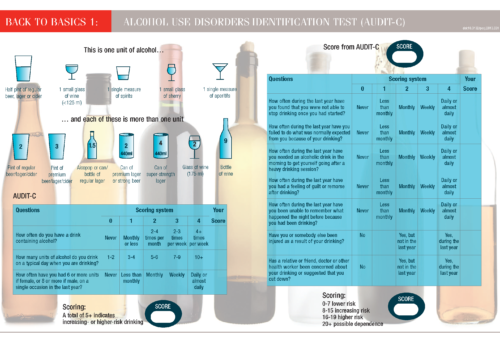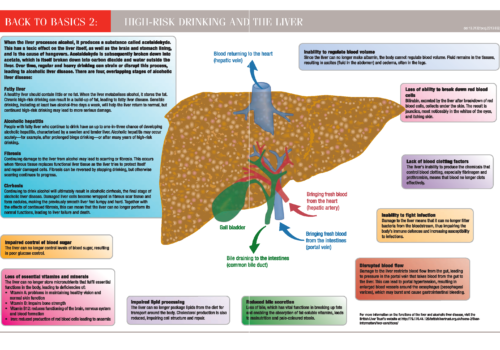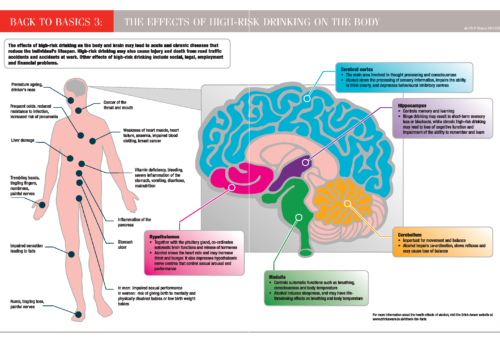We are a nation with an alcohol-induced dichotomy: we have a love affair with alcohol but are increasingly aware of its dangers. The pub has been a cornerstone of our society, providing a source of relationships and artistic imagination. However, our nation’s favourite drug is also responsible for as many life-years lost as tobacco, but with additional psychological and socio-economic costs.
How much are you drinking?
Ask, ask, ask…about alcohol
NHS Health Checks now include AUDIT-C, a brief screening tool designed to help identify people who may be problem drinkers. Taking the test can be a sobering experience for patients, but now is the time to get a grip on our national relationship with alcohol.
Back to Basics: Alcohol use disorders identification test (Audit-C)
Back to Basics: High-risk drinking and the liver
Back to Basics: The effects of high risk drinking on the body
Alcohol and the heart: food, medicine or poison?
People have been producing alcohol for thousands of years and consuming it as part of their diet as well as for medicinal purposes. When taken in moderation, drinking alcohol can be a safe and pleasurable activity with potential heart health benefits. However, those cardiovascular benefits are lost when alcohol is consumed in excess, and drinking becomes harmful with adverse physical, psychological and social consequences.
Alcohol and sex: a risky mixture for sexual health
Alcohol-related harm is a major public health concern, and since April 2013 questions to identify problem drinkers have been included in the NHS Health Check for people aged 40-74 years. But young people are also a key at-risk group for hazardous consumption, and the physical harms of alcohol may be compounded by risks to their sexual health.
Over the limit? A healthier approach to alcohol
Alcohol forms part of the diet for over 90% of adults in the UK and is unusual in being both a nutrient and a drug. For many of us, alcohol is a safe and pleasurable part of the diet. However, there is growing concern that many people who see themselves as social drinkers are consuming levels that may cause harm. Understanding how to assess safe levels of alcohol consumption and identify strategies for cutting down can help us to advise our patients how to moderate their intake.
Editorial
It has become increasingly clear that many people in this country are putting themselves at risk because they are continuing to drink above their recommended weekly units. Most of these people are not drunk drivers in police cells or antisocial drinkers arriving at A&E departments on Saturday night. They are people who come to see us at our chronic disease clinics or for treatment for an acute illness. The inclusion of questions about alcohol in NHS Health Checks is the ideal opportunity to discuss the potential risks of excessive drinking, and this special issue explains how we can help patients to choose a healthier approach to alcohol.
Over the limit? A healthier approach to alcohol
Alcohol forms part of the diet for over 90% of adults in the UK and is unusual in being both a nutrient and a drug. For many of us, alcohol is a safe and pleasurable part of the diet. However, there is growing concern that many people who see themselves as social drinkers are consuming levels that may cause harm. Understanding how to assess safe levels of alcohol consumption and identify strategies for cutting down can help us to advise our patients how to moderate their intake.
Helping dependent drinkers to give up alcohol
It has been estimated that one in every five patients in the UK drinks to excess, so the average English general practice may have as many as 1,000 problem drinkers. This size of problem can only be dealt with effectively if all members of the primary healthcare team are involved in supporting problem drinkers and ensuring that dependent drinkers are referred to appropriate specialist services.






















